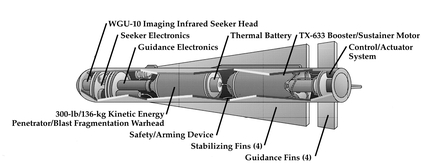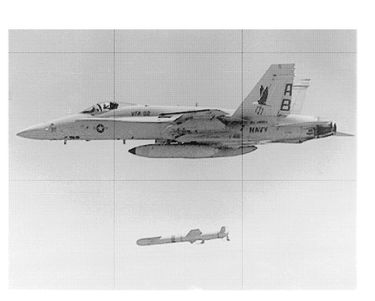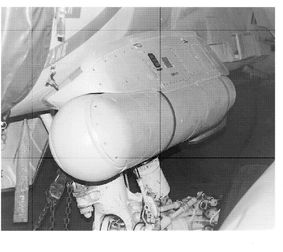Carrier (1999) (35 page)
Authors: Tom - Nf Clancy


A cutaway view of a Raytheon AGM-65 Maverick missile.
JACK RYAN ENTERPRISES, LTD., BY LAURA DENINNO
The Hornet can also employ other PGMs like the AGM-88 HARM antiradar missile, the AGM-65 Maverick tactical ASM, the AGM-84D Harpoon antishipping missile, and the new AGM-84E Standoff Land Attack Missile (SLAM).
58
SLAM is a relative newcomer to the fleet, having first been introduced and employed during Desert Storm in 1991. Since that time, SLAM has seen action in Bosnia in 1995, and has become one of the finest standoff strike weapons in the world. What makes it such a winner is the use of the basic (and very dependable) AGM-84 Harpoon engine, airframe, and warhead package, which is now married to a new guidance and seeker package. This new system combines a GPS/INS unit, an imaging infrared (IIR) seeker head from an AGM-65 Maverick ASM, and a man-in-the-loop data-link unit from the old Walleye guided bomb.
58
SLAM is a relative newcomer to the fleet, having first been introduced and employed during Desert Storm in 1991. Since that time, SLAM has seen action in Bosnia in 1995, and has become one of the finest standoff strike weapons in the world. What makes it such a winner is the use of the basic (and very dependable) AGM-84 Harpoon engine, airframe, and warhead package, which is now married to a new guidance and seeker package. This new system combines a GPS/INS unit, an imaging infrared (IIR) seeker head from an AGM-65 Maverick ASM, and a man-in-the-loop data-link unit from the old Walleye guided bomb.
The result is a weapon that achieved perhaps the most spectacular hit of Desert Storm. On its first combat “shot,” run against a heavily defended Iraqi weapons plant near Baghdad, two SLAMs were launched several minutes apart. The first missile, taking its basic guidance from the GPS/INS unit, flew to the target and locked up the desired aimpoint without difficulty. It then flew directly into the building wall, detonated, and made a very large hole. Several minutes later, the second SLAM flew through the hole created by the first missile and destroyed the equipment inside. Further success for the SLAM came during Operation Deliberate Force in Bosnia. The outstanding performance of SLAM has made it one of the most feared PGMs in the U.S. arsenal.
An AGM-84E SLAM missile being launched from an F/A-18C Hornet. SLAM was used during Operations Desert Storm and Deliberate Force, where it performed with amazing precision and lethality.
BOEING MILITARY SYSTEMS

In fleet service in its early years, the Hornet showed the shortcomings that had been seen in testing. While the F/A-18’s range limitations became obvious at once, for example, this could be improved simply by altering the altitude and speed (called the flight profile) that it flew during missions. Thus, the aircraft’s range could be stretched simply by flying it at higher altitudes, where the F404 engines were more efficient. Still, some of the Hornet’s original specifications would never be met, especially those of acceleration and range. Still, in the crucible of combat it passed the ultimate test. This first came in 1986, when a number of Hornet squadrons took part in operations against Libya. In ACM engagements against the MiGs and Mirages of the Libyan Air Force, the Hornets had no trouble staying on the tails of the opposing warplanes. They also helped suppress the Libyan air defenses with HARM missiles, another role they took over from the A-7E. The Hornet provided the Navy with one other pleasant surprise: its incredible reliability compared with other Navy aircraft like the F-14 and A-6. This meant that the Hornet was cheaper to operate, and could be flown more often than other comparable aircraft—so often, in fact, that the early F/A-18As wore out faster than expected, and had to be replaced earlier than planned. This led to an improved variant, the F/A-18C/D, which arrived in the fleet during 1986.
The -C/D model gained some weight over the -A/B Hornets, but unfortunately did not carry any more gas. The radar, avionics, engines, and other systems were significantly improved, however, including provisions to carry the AIM-120 AAM and IIR version of the AGM-65 Maverick ASM. The new Hornet also had a new-generation monitoring system that allowed maintenance crews to diagnose problems automatically and even predict when individual components and “black boxes” might fail. There were also provisions for the new Hornet to be operated at night with night-vision goggles (NVGs), and a new radar: the APG-73 (planned for the new F/A-18E/F Super Hornet).
The F/A-18C/D was the Hornet that the Navy and Marines had wanted all along; and the Marine Corps bought six squadrons of modified -D models as night-attack aircraft to replace their force of retired A-6’s. The Hornet was also becoming something of a success in the export market. The first foreign customer was Canada, which bought 138 CF-18’s to conduct continental air defense as part of the North American Air Defense (NORAD) Command. Australia (seventy-five), Kuwait (forty), Spain (seventy-two), Switzerland (thirty-four), Finland (sixty-four), Thailand (eight), and Malaysia (eight) also bought various models of the F/A-18 to upgrade their air forces. All told, around 1,500 Hornets have been built to date.
By the time of the Iraqi invasion of Kuwait in 1990, the Hornet had been in service for almost a decade and was ready for its biggest combat challenge. Almost as soon as the U.S. began to react to the invasion, F/A-18 units were in the front lines of Desert Shield. Eventually, five carrier groups and an entire Marine Air Wing with Hornets as their backbone deployed into the theater. The Canadians also contributed a squadron of their CF-18’s to the effort. In Desert Storm the F/A-18 proved to be a deadly air-to-air killer. On January 17th, a pair of VF-81 Hornets from the USS
Saratoga
(CV-60) downed a pair of Iraqi F-7’s (Chinese MiG-21 clones) with a salvo of “in-your-face” AAM shots. The two F/A-18’s were loaded for a bombing mission at the time, but quickly switched to the air-to-air mode, shot down the enemy fighters, then went on to complete their bombing mission. The rest of the war was mainly spent delivering “iron” bombs onto battlefield targets in Kuwait and Iraq. In this mission, the success of the Hornets was something less than total.
Saratoga
(CV-60) downed a pair of Iraqi F-7’s (Chinese MiG-21 clones) with a salvo of “in-your-face” AAM shots. The two F/A-18’s were loaded for a bombing mission at the time, but quickly switched to the air-to-air mode, shot down the enemy fighters, then went on to complete their bombing mission. The rest of the war was mainly spent delivering “iron” bombs onto battlefield targets in Kuwait and Iraq. In this mission, the success of the Hornets was something less than total.
Part of the problem was the weather, which was the worst on record in the region. Because many of the bombing sorties required visual identification of the targets, some of these had to be aborted due to the cloud cover. There was also a requirement that bombs be delivered from medium altitude (above 10,000 feet/3,048 meters), making the accuracy of the results uncertain. Had the Hornet been armed with LGBs and other precision weapons, this problem would not have arisen. Unfortunately, the new version of the Nighthawk pod (with the laser designator and tracker) had not yet come into service.
There also was the fuel problem. Since most of the Hornets were based on carriers in the Red Sea, they required several in-flight refuelings in order to reach their targets in Iraq and Kuwait. This placed a severe burden on the limited airborne tanker resources of General Horner’s Central Command Air Force (CENTAF). This meant that the F/A-18’s were sometimes left off the daily Air Tasking Order (ATO) in favor of other aircraft, like USAF F-16’s, which were based closer to their targets. Eventually, the Navy moved a total of four carrier groups into the Persian Gulf itself, to bring the Hornets close enough to their targets to do some real good.
An AAQ-38 Nighthawk laser targeting pod, mounted on the starboard fuselage station of an F/A-18C Hornet. This pod allows Hornet crews to deliver laser-guided bombs and other precision munitions.
JOHN D. GRESHAM

By the time Hornets next went into combat (in Bosnia in 1995), a number of improvements had been made. The -C/D-model Hornets had been rearmed with new AIM-120 AMRAAM AAMs, SLAM ASMs, and Paveway LGBs guided by their new Nighthawk targeting pods. And this time, their carrier, the USS
Theodore Roosevelt
(CVN-71), operated closer to shore than was the practice in Desert Storm and they were given adequate tanker support from NATO/USAF resources. Now that they were properly supported and armed, the PGM-armed Hornets (including a squadron of Marine F/A-18D Night Attack variants) were the heart of Operation Deliberate Force in 1995, and did all that was asked of them. In fact, Navy and Marine Corps Hornets dropped and launched the bulk of the PGMs that were used during the Bosnia strikes.
Theodore Roosevelt
(CVN-71), operated closer to shore than was the practice in Desert Storm and they were given adequate tanker support from NATO/USAF resources. Now that they were properly supported and armed, the PGM-armed Hornets (including a squadron of Marine F/A-18D Night Attack variants) were the heart of Operation Deliberate Force in 1995, and did all that was asked of them. In fact, Navy and Marine Corps Hornets dropped and launched the bulk of the PGMs that were used during the Bosnia strikes.
Today the Hornet is the backbone of U.S. carrier aviation, and will remain that way for at least the next decade. Every CVW is being equipped with three F/A-18 squadrons (each with twelve aircraft), which means that fully half of the aircraft on U.S. carrier decks today are Hornets. There will soon be significant Hornet upgrades, with the introduction of new PGMs, as well as a new version of the classic AIM-9 Sidewinder. Even so, there can be little doubt that the F/A-18’s short legs, limited weapons load, and design compromises will continue to be a lightning rod for critics. Still, the folks who fly the Hornet love their mounts. Though it’s a flying compromise, it’s easy to fly, forgiving for new pilots, and capable of many different missions.
EA-6B Prowler: The Electric BeastLooking like a flying metal tadpole, the EA-6B Prowler will probably be the last survivor of a long line of Grumman carrier aircraft that date back to before the Second World War. Its mission is electronic warfare (EW), which explains why the aircraft looks like a flying antenna farm. As many as thirty (or more) antennas are smoothly faired into the fuselage or packed into the “football” (actually, it looks more like a Brazil nut), a fiberglass radome at the top of the vertical stabilizer. These devices allow the Prowler to throw an invisible veil of protection over the aircraft and ships of the carrier battle group. They detect, classify, and locate enemy radar, electronic data links, and communications, then jam them with precisely crafted and targeted interference. And as an added bonus, since 1986 Prowlers have also been capable of making “hard kills” using the AGM-88 High-Speed Anti-Radiation Missile (HARM), which homes in on radar transmitters and shreds them with a blast-fragmentation warhead.
53
53
Today, the Prowler is the finest tactical EW aircraft in the world. It’s so good that the USAF is quietly retiring its own fleet of EF-111 Raven EW aircraft and employing EA-6Bs in joint (USN/USAF) squadrons. All this is even more impressive when you consider that the thirty-year-old Prowler design has been around for almost half of the six decades that radar has been used in military operations; and with regular updates, it has at least another ten or fifteen years to go.
Electronic warfare (intercepting and jamming enemy signals) began with the first military use of radio in the Russo-Japanese War (1905), and reached a high degree of sophistication during the Second World War, as Axis and Allied scientists and technicians fought for control of the electromagnetic spectrum. EW aircraft have been in use since World War II, with modified USN TBF/TBM Avengers being among the first such aircraft. The start of the Vietnam War saw two carrier-capable EW birds in service with the Navy, though both were already getting old. The EA-1E was a modification of the classic Douglas AD-1 Skyraider, while the EKA-3B “Electric Whale” (which also served as a tanker aircraft) was a development of the Cold War-era A-3 Skywarrior attack bomber. As American aircraft began to fall to radar-controlled AAA guns, SAMs, and MiGs over Vietnam, the need for a third-generation EW aircraft became almost desperate. Out of this need came the development of what would become the EA-6 Prowler.
The original airframe of the Prowler was derived from the A-6 Intruder, which was the Navy’s first
true
all-weather, day or night, low-level medium-strike aircraft. The Intruder saw extensive combat in Vietnam, the Cold War, and Desert Storm, and was immortalized in Stephen Coonts’s 1986 novel,
Flight of the Intruder.
The Prowler’s immediate ancestor, the EA-6A, was a modified two-seat “Electric Intruder” developed to fill a Marine Corps requirement for a jammer aircraft that could escort strike missions into the high-intensity threat of North Vietnam’s integrated air defense system. Hard-won experience showed that what was really needed for such missions were more EW operators and jammers aboard the aircraft. From this came the all-new EA-6B Prowler, which is an all-weather, twin-engine aircraft manufactured by Northrop Grumman Aerospace Corporation as a modification of the basic A-6 Intruder airframe. The first flight of the EA-6B was on May 25th, 1968, and it entered operational service in July of 1971. Just a few months later, the Prowler entered combat over Vietnam with VAQ-132, based on aircraft carriers in the Gulf of Tonkin.
true
all-weather, day or night, low-level medium-strike aircraft. The Intruder saw extensive combat in Vietnam, the Cold War, and Desert Storm, and was immortalized in Stephen Coonts’s 1986 novel,
Flight of the Intruder.
The Prowler’s immediate ancestor, the EA-6A, was a modified two-seat “Electric Intruder” developed to fill a Marine Corps requirement for a jammer aircraft that could escort strike missions into the high-intensity threat of North Vietnam’s integrated air defense system. Hard-won experience showed that what was really needed for such missions were more EW operators and jammers aboard the aircraft. From this came the all-new EA-6B Prowler, which is an all-weather, twin-engine aircraft manufactured by Northrop Grumman Aerospace Corporation as a modification of the basic A-6 Intruder airframe. The first flight of the EA-6B was on May 25th, 1968, and it entered operational service in July of 1971. Just a few months later, the Prowler entered combat over Vietnam with VAQ-132, based on aircraft carriers in the Gulf of Tonkin.
Other books
The Shadowed Manse by David Alastair Hayden, Pepper Thorn
The Desperate Wife’s Survival Plan by Alison Sherlock
MOON FALL by Tamara Thorne
1 Dicey Grenor by Grenor, Dicey
Begin Again: Short stories from the heart by Campisi, Mary
The Texas Ranger's Reward (Undercover Heroes) by Winters, Rebecca
Working Stiff by Grant Stoddard
Shadows on Snow: A Flipped Fairy Tale (Flipped Fairy Tales) by Starla Huchton
Best Friends Forever by Jennifer Weiner
Captured By You: A One Night of Passion Novella by KERY, BETH
